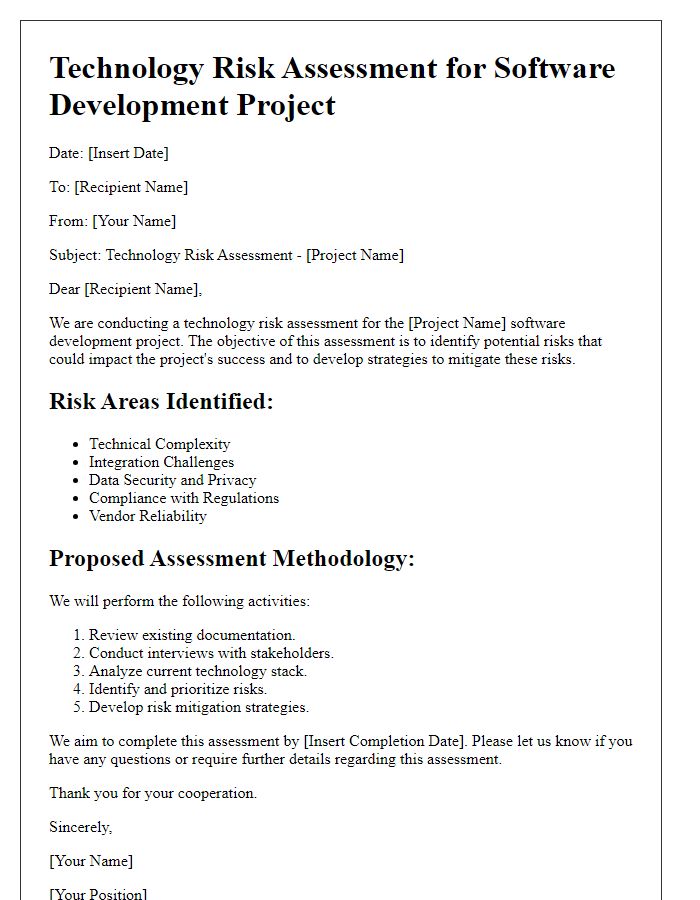In today's rapidly evolving digital landscape, understanding technology risk assessment is more important than ever. Businesses face a myriad of potential threats that could jeopardize their data and operations, making it crucial to have a clear strategy in place. By conducting a thorough risk assessment, organizations can identify vulnerabilities and take necessary precautions to safeguard their assets. Curious to learn how to effectively assess technology risks in your own organization? Keep reading for valuable insights and tips!

Objective and Scope of Assessment
The technology risk assessment aims to identify and evaluate potential vulnerabilities within the IT infrastructure of an organization, particularly focusing on systems, applications, and data storage solutions. The scope encompasses critical components such as network architecture, cloud services (like Amazon Web Services and Microsoft Azure), and endpoint devices (including laptops and smartphones). Key objectives involve assessing the impact of cyber threats, such as data breaches and ransomware attacks, by quantifying risks associated with unauthorized access to sensitive data (which could include personal identifiable information or confidential business information), system downtime (potential costs estimated in thousands per hour), and compliance violations regarding regulations like GDPR or HIPAA. The assessment will also explore the organization's incident response capabilities and overall cybersecurity posture to ensure sufficient protections are in place against evolving threats in the digital landscape.
Identification of Technologies and Systems
In the realm of technology risk assessments, the identification of technologies and systems is paramount, encompassing various components such as hardware, software, and networking solutions. Critical systems, like enterprise resource planning (ERP) software utilized by companies such as SAP, play an essential role in streamlining business operations. Network infrastructure, including routers manufactured by Cisco and firewalls like Fortinet, provides the backbone for secure communications. Additionally, cloud services, exemplified by Amazon Web Services (AWS) and Microsoft Azure, house vast amounts of sensitive data, necessitating thorough scrutiny. Emerging technologies, such as artificial intelligence (AI) algorithms in platforms like TensorFlow, also introduce new risks that organizations must evaluate meticulously. Overall, a comprehensive understanding of existing and emerging technologies is crucial to mitigate potential threats and vulnerabilities effectively.
Potential Risks and Vulnerabilities
Potential risks and vulnerabilities in technology systems can significantly impact organizational security and efficiency. Cybersecurity threats such as malware attacks created by hackers can compromise sensitive data, potentially costing businesses millions of dollars in recovery and breach notification expenses. Unpatched software vulnerabilities, like those found in outdated operating systems, can allow unauthorized access to systems, leading to data loss or theft. Cloud computing provides convenience but exposes data to risks such as data breaches and account hijacking, impacting confidentiality. Additionally, insider threats from employees with access to critical systems can intentionally or unintentionally lead to data leaks or operational disruptions. Compliance failures with regulations such as GDPR (General Data Protection Regulation) can result in hefty fines and reputational damage. Regular and comprehensive risk assessments are essential for identifying these vulnerabilities and implementing effective mitigation strategies.
Impact Analysis and Mitigation Strategies
Technology risk assessment involves a thorough impact analysis of potential threats to critical systems, data integrity, and operational efficiency. High-risk areas like cyberattacks often target sensitive information, leading to significant financial loss (up to 60% revenue decline for businesses affected). Identifying vulnerabilities in infrastructure, such as outdated software (with a 30% higher breach rate), enhances the understanding of risk exposure. Mitigation strategies may include implementing advanced encryption protocols (AES-256 standard) and regular system updates (monthly schedule for patch management). Additionally, employee training programs on cybersecurity best practices can reduce human error, which is responsible for nearly 90% of data breaches. Overall, utilizing a risk assessment framework, like NIST or FAIR, is essential for establishing a proactive stance against technological threats.
Compliance and Regulatory Considerations
Compliance with technology regulations involves understanding various frameworks such as GDPR (General Data Protection Regulation) for data protection, HIPAA (Health Insurance Portability and Accountability Act) for health information in the United States, and PCI DSS (Payment Card Industry Data Security Standard) for payment security. Organizations must assess their technology stack, including software applications, cloud services, and network infrastructure, ensuring adherence to legal statutes. Regular audits should be conducted, focusing on data encryption, user access control, and incident response plans. Non-compliance can result in hefty fines, reputational damage, and increased scrutiny from regulatory bodies. Technologies such as data loss prevention (DLP) tools and compliance management software can aid in monitoring adherence to these regulations, facilitating smoother reporting to authorities like the FTC (Federal Trade Commission) and maintaining public trust.
Letter Template For Technology Risk Assessment Samples
Letter template of technology risk assessment for software development projects

Letter template of technology risk assessment for cybersecurity measures

Letter template of technology risk assessment for cloud migration strategies

Letter template of technology risk assessment for data privacy compliance

Letter template of technology risk assessment for IT infrastructure changes

Letter template of technology risk assessment for third-party vendor evaluations

Letter template of technology risk assessment for digital transformation initiatives

Letter template of technology risk assessment for emerging technologies adoption






Comments